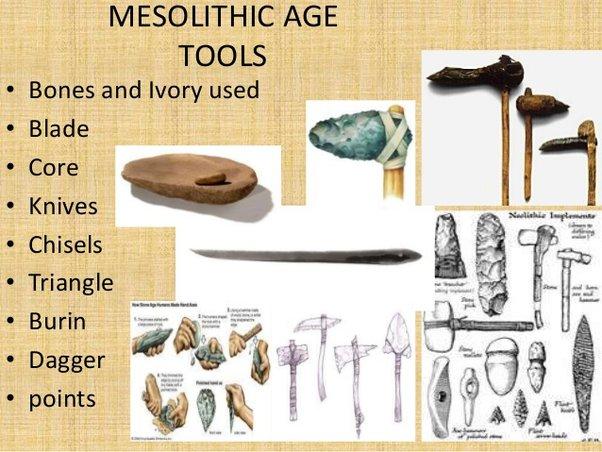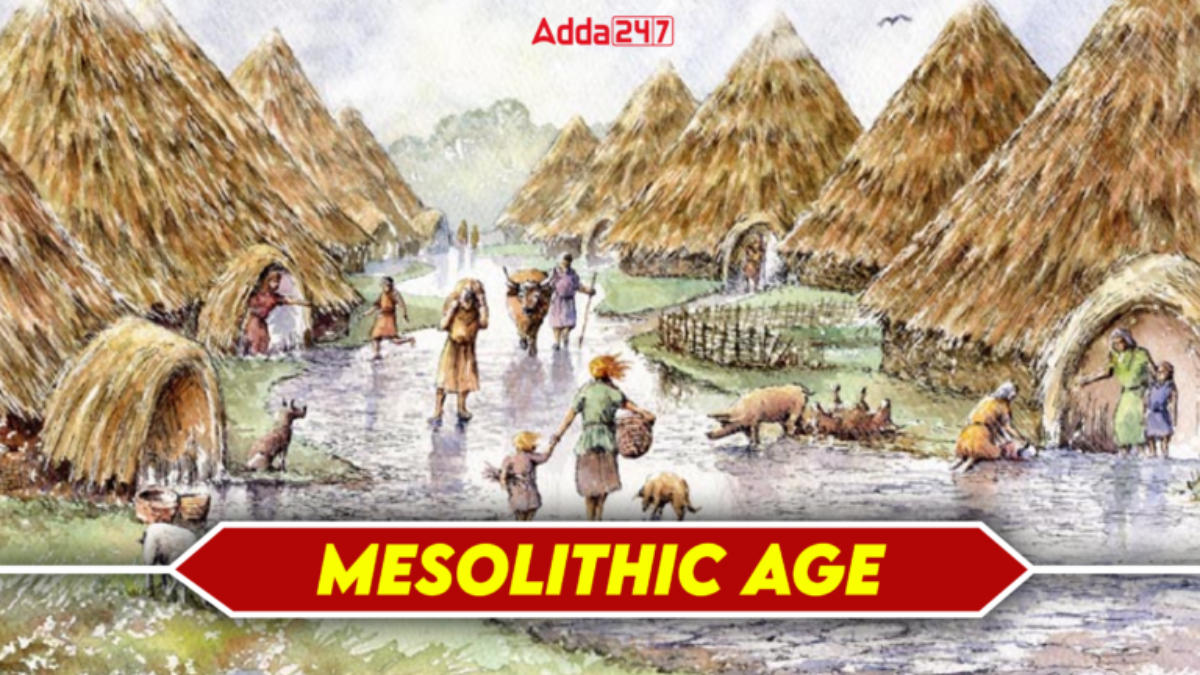Table of Contents
Between the Paleolithic and Neolithic eras, the Mesolithic Age, which lasted roughly from 10,000 to 6,000 BCE, is a significant period of history. The transition from nomadic hunter-gatherer lifestyles to more established societies throughout this era signaled a fundamental shift in human cultural systems. Mesolithic hunter-gatherer societies flourished throughout much of India, depending on the abundance of the natural world for food. Their main sources of income were wild game hunting and plant collection, which allowed them to live as nomads while they wandered around looking for supplies.
This article provided details about the intricacies of the Mesolithic Age, offering insights crucial for aspirants preparing for both the UPSC IAS exam and those pursuing Anthropology Optional.
Mesolithic Age
The Mesolithic Age, often referred to as the Middle Stone Age, holds pivotal significance in human history, bridging the gap between the Paleolithic and Neolithic eras. As humanity grappled with environmental changes, this epoch witnessed crucial adaptations to evolving landscapes and climates. The term “Mesolithic” originates from the Greek words “mesos,” meaning middle, and “lithos,” meaning stone, underscoring its position as an intermediary phase between antiquity and progress.
Central to this period’s identity is the advent of microlithic tools, exemplifying remarkable advancements in technology and craftsmanship. These intricate implements, encompassing blades, scrapers, arrowheads, and piercers, bear testament to the cognitive and inventive prowess of Mesolithic communities.
Facts about Mesolithic Age
In the below points, some of the facts are mentioned, which provide detailed information bout the Mesolithic Age which also helps to gain more knowledge. Read the following information below.
- The Mesolithic Age in India extended from approximately 10,000 to 6,000 B.C., serving as a transitional period between the Paleolithic and Neolithic Ages.
- Initially, the inhabitants of this era relied on hunting, fishing, and gathering for sustenance; however, they later adopted animal domestication practices.
- Microliths emerged as the hallmark tools of this period, showcasing a distinctive advancement in stone tool technology.
- Artistic expression flourished during the Mesolithic Age, with evidence of painted rock shelters discovered in Bhimbetka, Madhya Pradesh. These paintings often depicted scenes of birds, animals, and human figures.
- Mesolithic sites have been unearthed in various regions of India, including Rajasthan, areas south of the river Krishna, central and eastern parts of the country, as well as southern Uttar Pradesh.
- Notable examples of Mesolithic sites in India include Bagor in Rajasthan and Adamgarh in Madhya Pradesh, highlighting the rich archaeological heritage of the era.
The table provided below shows a concise overview of the Mesolithic Age in India, highlighting its duration, key features, and notable archaeological sites.
| Duration | Approximately 10,000 to 6,000 B.C. |
| Transitional Phase | Bridges the Paleolithic and Neolithic Ages |
| Subsistence Strategies | Initially based on hunting, fishing, and gathering; later included animal domestication |
| Key Tools | Microliths |
| Artistic Expression | Evidence of painted rock shelters depicting birds, animals, and human figures found in Bhimbetka, Madhya Pradesh |
| Distribution of Sites | Mesolithic sites discovered in Rajasthan, areas south of the river Krishna, central and eastern parts of India, and southern Uttar Pradesh |
| Notable Sites | Bagor in Rajasthan and Adamgarh in Madhya Pradesh |
Characteristics of Mesolithic Age
Here are the salient features of the Mesolithic Age in India provided below:
- Occurred approximately from 15,000 to 7,000 BCE, succeeding the Upper Paleolithic and preceding the Neolithic periods.
- Microliths emerged as hallmark tools, crafted into knife blades, arrowheads, and perforators, showcasing advanced stone tool technology.
- Subsistence primarily relied on hunting, fishing, and gathering, targeting animals like deer and pigs, along with gathering wild plants.
- Settlements were transient and seasonal, with communities frequently relocating in search of resources. Temporary huts or rock shelters likely served as dwellings.
- Evidence of burial practices suggests the presence of religious and ritualistic beliefs. Rock paintings and engravings depict aspects of Mesolithic art.
- Technological advancements included blade and microlith innovations, showcasing complex tool-making skills. Bones and antlers were utilized for tool crafting.
- The climate was characterized by wetter and cooler conditions compared to the Upper Paleolithic, prompting adaptations to changes in flora and fauna.
Tools Utilized in Mesolithic Age
During the Mesolithic period, individuals employed a diverse array of tools to meet their daily needs.
- The primary tool category during this era was microliths, which comprised small-bladed stone implements. Microliths exhibited both geometric and non-geometric shapes. Geometric variants included designs like trapeze, triangle, lunate, or crescent, while non-geometric types were categorized based on the blunting of their edges, such as partly, fully, or obliquely blunted blades. These versatile tools were utilized for tasks ranging from plant gathering and harvesting to slicing, grating, and processing plant fibres.

- Another class of tools found in the Mesolithic Age was microliths, which exceeded microliths in size. Continuing the lineage of Upper Paleolithic implements like scrapers, macroliths were considered heavy-duty tools, capable of handling more robust tasks.
- In addition to stone tools, Mesolithic communities employed bone and antler implements. Crafted from animal bones and antlers, these tools served various purposes, including cutting, scraping, and hunting activities, showcasing the ingenuity and resourcefulness of Mesolithic toolmakers.
Art of Mesolithic Period
The artistry of the Mesolithic period represented a notable departure from the expressive forms observed in the preceding Paleolithic era. While Paleolithic art primarily centred on cave paintings and portable figurines, the Mesolithic era witnessed a diversification of artistic attempts.
- A prominent feature of Mesolithic art was the creation of rock art. Humans adorned cave walls, rock shelters, and boulders with paintings, engravings, and carvings. These artistic expressions often depicted a rich tapestry of animals, human figures, hunting scenes, and symbolic motifs. Likely serving purposes ranging from communication to storytelling, these artworks also bore religious and ritualistic significance.
- In addition to rock art, Mesolithic artisans crafted small-scale sculptures and figurines. Utilizing materials such as bone, antler, or stone, these sculptures commonly portrayed animals like deer or fish, as well as human forms. These figurines likely held symbolic or ceremonial importance within Mesolithic societies.

- Personal adornment also emerged as a significant aspect of Mesolithic culture. Crafting jewellery and ornaments from materials like shells, teeth, bones, and stones, individuals adorned themselves with items that served both aesthetic and symbolic functions, reflecting the artistic sensibilities and cultural nuances of Mesolithic communities.
Mesolithic Culture
The Mesolithic culture encompasses the societal practices and customs observed during the Mesolithic period, marked by notable technological advancements and artistic endeavours.
- Technologically, Mesolithic societies made remarkable strides. They introduced innovations such as the bow and arrow, transforming hunting methods and enhancing efficiency. Additionally, they utilized querns, grinders, and hammer stones to process plant foods like roots and tubers, facilitating adaptation to their environment.
- Artistry held significant importance within Mesolithic culture. Communities produced a diverse array of artistic expressions, including paintings and engravings, reflecting their creativity and cultural richness.

Chronology of Mesolithic Age
Candidates can check the Chronology of the Mesolithic Age which is provided below:
- The Mesolithic period endured from 10,000 to 4,000 BC in North/Western Europe.
- In Central Europe, the Mesolithic persisted from 10,000 to 5,500 BC.
- East Asia experienced the Mesolithic era from 10,000 to 6,000 BC.
- Southeast Europe saw the Mesolithic era extend from 10,000 to 7,000 BC.
- The Mesolithic period lasted from 10,000 to 6,000 BC in the Middle East and other regions.
- In India, the Mesolithic era spanned approximately from 9,000 BC to 4,000 BC.
List of Indian Mesolithic sites, locations, and characteristics
Check the table below for the list of Indian Mesolithic sites, locations, and characteristics below:
|
Name of Mesolithic Sites
|
Location
|
Characteristics
|
|
Bagor
|
Rajasthan
|
It had a microlithic industry and its people lived on hunting and pastoralism.
|
|
Adamgarh
|
Madhya Pradesh
|
It shows the earliest evidence for the domestication of animals.
|
|
Bhimbetka
|
Madhya Pradesh
|
It has more than 500 painted rock shelters.
|
|
Langhnaj
|
Gujarat
|
Provides the earliest evidence of the burial of the dead.
|
|
Mohrana Pahara
|
Mirzapur, Uttar Pradesh
|
Provides the earliest evidence of burial.
|
Around 10,000 BC, a warming trend unfolded, altering the climate gradually. This change prompted the migration of large animals towards colder regions to the North, resulting in the extinction of species like mammoths, elk, woolly rhinos, and bison. As temperatures rose, forests began to blanket the Netherlands, fostering rich biodiversity. These environmental shifts marked the dawn of the Middle Stone Age, signalling the commencement of prehistoric exploration at Archeon.


 Position of Women in Vedic Age: Societie...
Position of Women in Vedic Age: Societie...
 Bishnoi Movement - History, Objective, a...
Bishnoi Movement - History, Objective, a...
 Bodhisattvas: History, List of Bodhisatt...
Bodhisattvas: History, List of Bodhisatt...







